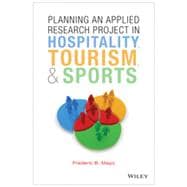Planning an Applied Research Project in Hospitality, Tourism and Sports provides a comprehensive and carefully structured treatment of all the aspects involved in planning a research project. Instead of being a statistically oriented book, this text provides a conceptual and process-oriented approach to planning and conducting research. Written for both students and professionals, it is easy to read, short, and to the point, i.e., practical. The book provides basic, yet comprehensive information about doing research, and can be used not only in a “research methods” course where students will have to plan and conduct a research project, but also in earlier course work to help students learn to write research papers. Planning an Applied Research Project in Hospitality, Tourism and Sports covers a range of subjects including: selecting a topic, conducting a literature review, developing a coherent design, and using various research techniques such as interviews, questionnaires, and observations. It also contains information on analyzing data once it has been collected and developing a proposal to obtain support before undertaking a research project. Unique coverage includes: 2 chapters on conducting and writing a literature review, 1 chapter on analyzing data (from both a qualitative and quantitative perspective), 1 chapter on writing a research proposal, and 3 detailed chapters on techniques.








